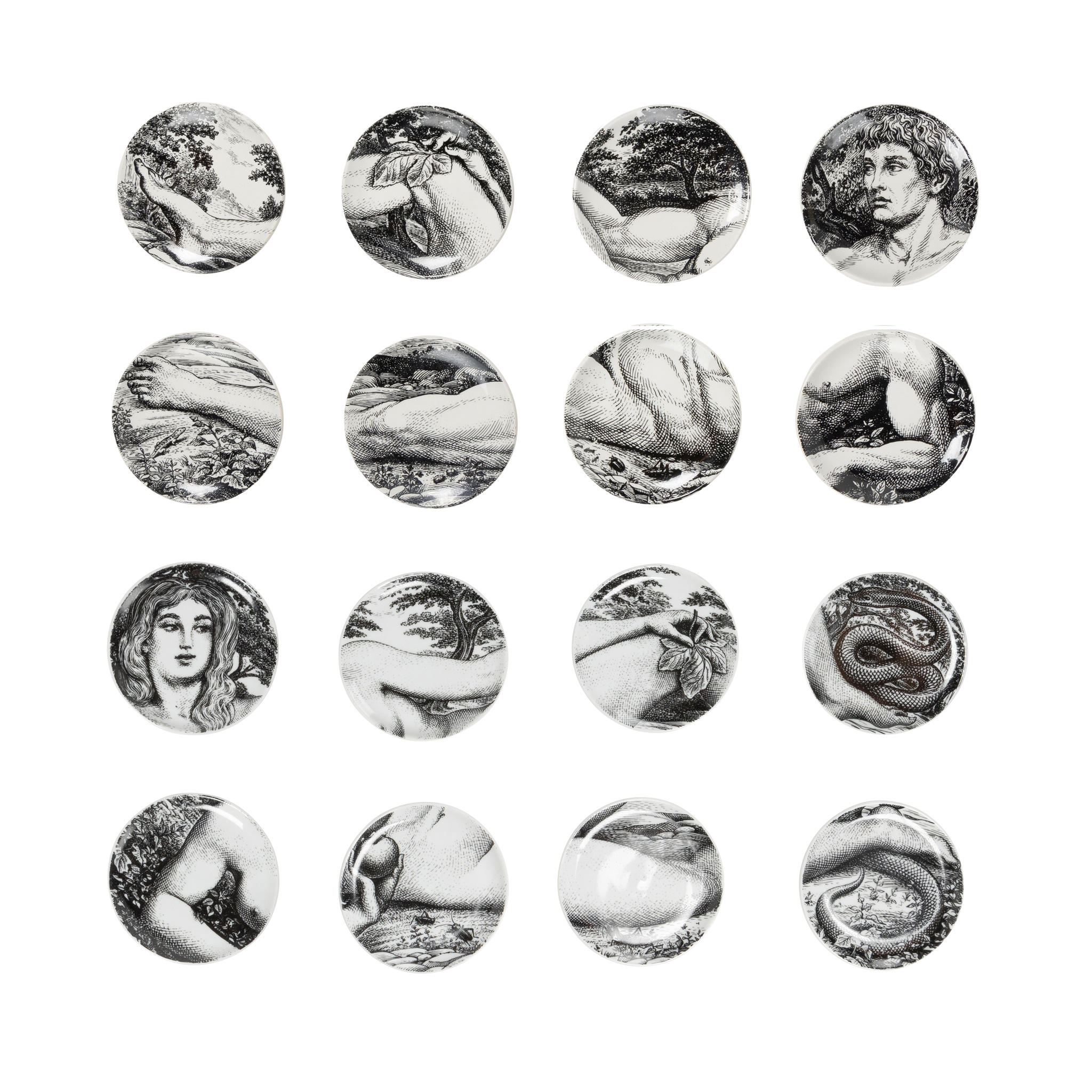Piero Fornasetti (Italian 1913-1988) †
'Adam' and 'Eve' Coaster Sets, circa 1965
£1,512
Auction: 27 October 2023 from 11:00 BST
Description
comprising 16 coasters, printed manufacturer's marks (to reverse of each coaster), porcelain, in original boxes
Dimensions
Adam Coasters: 10.5cm diameter (4 1/8in diameter); Eve Coasters: 9.8cm diameter (3 7/8in diameter)
Footnote
Piero Fornasetti: Designer of Dreams
Our work is without limits, full time. There is no schedule, day or night. I translate my dreams into reality, whatever I do. Piero Fornasetti
Piero Fornasetti’s oeuvre stands as a testament to his lifetime obsession with art and design. Unrelenting in his pursuit of ornate decoration, irony and illusion, Fornasetti created a unique dream-like world blending classical and exotic imagery to create a globally recognised style that has withstood the test of time.
From the very beginning of his career, Fornasetti’s purpose and direction was always clear to him, as he recalled in 1987: ‘I was born a painter. I began at the age of ten. Nobody in the workshops where I went could teach me. I learned from books, lithography and etching, all this before the founding of specialised schools.’
The roots of Fornasetti’s designs are firmly placed in the past. Over his lifetime he collected an extensive library of engravings which fuelled his imagination with Classical and Renaissance imagery. These images became the basis of all Fornasetti’s work and whilst his designs were never taken from any particular print, he recreated their likeness through the meticulous use of lines and dots. Fornasetti was an excellent draughtsman and printer and evolved the concept of the engraving aesthetic through playful use of scale and composition. Within the sale this is demonstrated with the Adam and Eve coasters (Lot 218) where Fornasetti portrays this well-known story across 16 different coasters. By taking the image away from a more traditional context, Fornasetti introduces his style to a whole new audience and by breaking down the image into individual parts he encourages the viewer to use their imagination to complete the picture.
Further influences came from Surrealist Metaphysical paintings by Alberto Savinio and Giorgio de Chirico, as well as artists like Pablo Picasso and Jean Cocteau. Fornasetti embraced the playful ideas of Surrealism, injecting a sense of humour and irony into his work. He was also fascinated by the correlation between architecture and furniture in that both have façades and doors which open to reveal interior spaces.
In the 1950s Fornasetti embarked on a collaboration with Gio Ponti which was to bring the two men international recognition. Both were devoted to ideas of over-decoration and set about designing pieces which conjured illusions to hide the functionality of the object. By adapting 17th- and 18th-century prints to the exact dimensions of bureau desks Fornasetti transformed each one into a piece of monumental Italian architecture completely disguising their original purpose. Perhaps it is not surprising that Ponti’s belief in his long-time collaborator’s ability was so great that he proclaimed he had the ability to ‘make an object speak’.
Fornasetti’s chair backs of Ionic and Corinthian capitals are perhaps the most well-known examples of his use of classical architecture. Two original examples from 1950s, together with a Renaissance inspired ‘Boomerang’ chair, are presented in this sale (lots 219, 220, and 221). Musical instruments were a favourite motif for Renaissance artists and Fornasetti immersed himself in this tradition. He was especially intrigued by their shape and the sound images that they evoked.
Around this time the principles of Modernist design were starting to gain popularity. Ornamentation and representation of historical and natural references had fallen out of fashion in favour of a simplistic function- led approach. Unfortunately for Fornasetti these were the very things that he had dedicated his life to creating and subsequently with time his designs started to lose their appeal. However, he was resolute in his approach, arguing that an artist who compromised their beliefs in order to be successful was no longer an artist. He stated:
‘He is a person who wants to have success. If he conforms to fashion, he will arrive late because by now everyone has already conformed. Therefore, perhaps the idea is not to conform but to be original. For example, I am suggesting the idea of creating fashion items that never go out of fashion.’
England was central to the rediscovery of Fornasetti in the 1980s when two designers Guiliana Medda and Lilianne Fawcett opened their shop Themes and Variations in London. Selling a wide selection of Fornasetti objects they encouraged a revival of 1950s fashions. In 1991 the Victoria & Albert Museum held a comprehensive retrospective of Fornasetti’s work supported by his son Barnabus. This led to a resurgence of interest in and the popularity of the artist which has lasted ever since. It is thus fitting that when he died in 1988, the card announcing Fornasetti’s death simply said: ‘My fantasy is always with you’.

